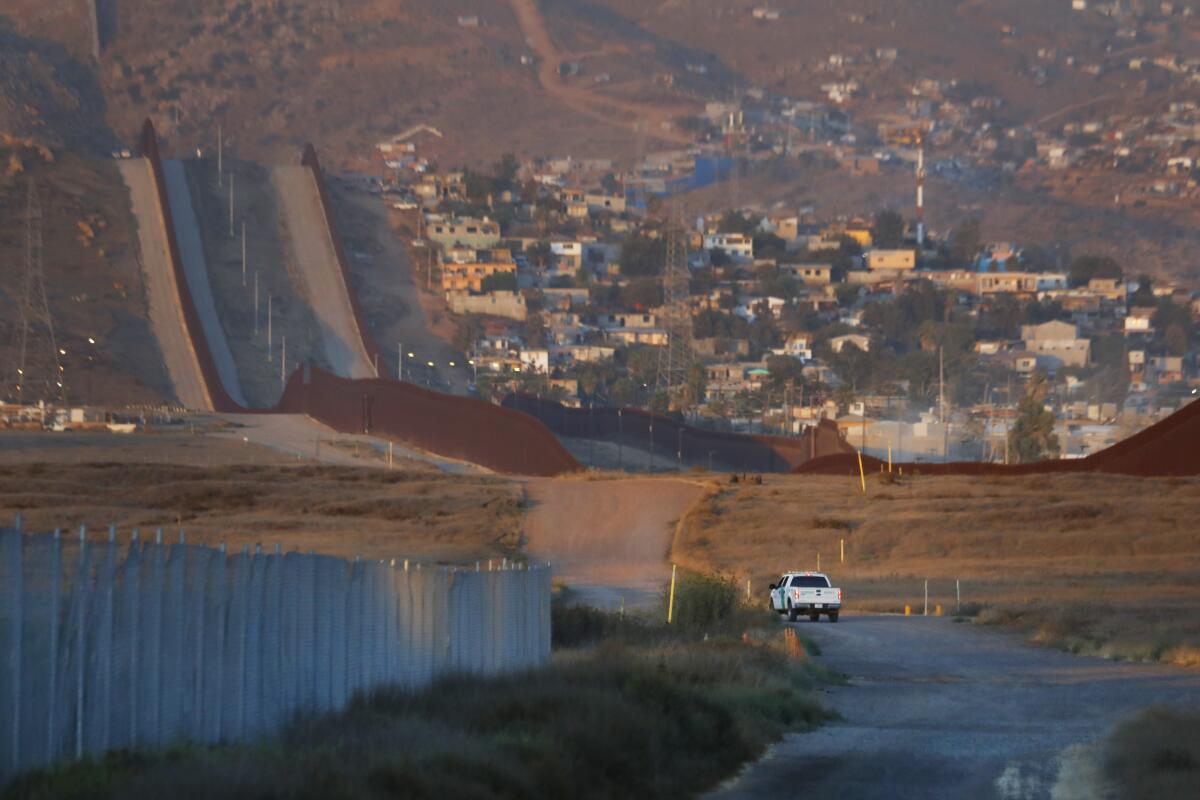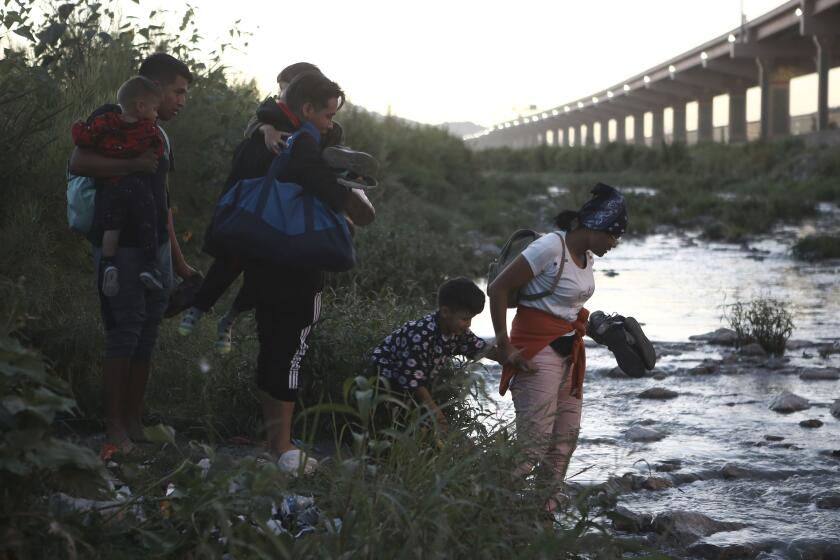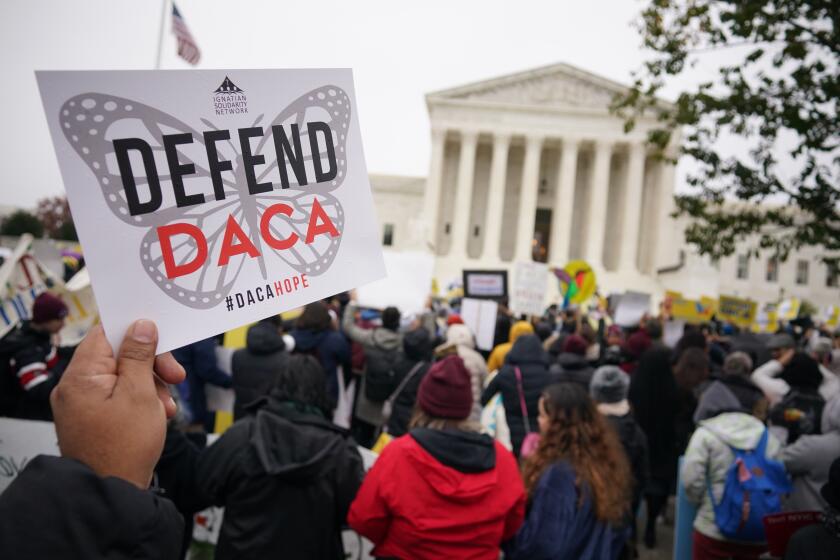Editorial: Two misconceptions and a truth about the U.S.-Mexico border

- Share via
The myths — or, rather, convenient lies — that some politicians keep circulating about the U.S.-Mexico border have resulted in another disappointing congressional session for immigration reform.
Instead of crafting much-needed solutions to address the fate of young immigrant “Dreamers,” the backlog of cases in immigration courts or any of the myriad problems caused by outdated immigration laws, policymakers spent most of their time wrangling over Title 42, a public health order invoked during the COVID-19 pandemic to manage border crossings.
Disinformation prevents policymakers from having honest discussions and enacting sensible solutions. The complex U.S.-Mexico border region is a confluence of cultural, social and economic communities whose problems need sophisticated solutions not easily summarized by sound bites. Yet many people continue to peddle misconceptions about the border and engage in partisan theater such as dispatching migrants to Vice President Kamala Harris’ home or creating a wasteful wall of shipping containers, as the Arizona governor has done.
The debate on immigration and border control is likely to intensify in early 2023, when the GOP takes control of the House. Though there’s little expectation of significant legislation in a divided Congress, the constant arrival of migrants at the border is sure to keep the topic in the news. Because it’s important to look beyond sound bites, we’re fact-checking the misconceptions about the U.S.-Mexico border you are likely to hear in the coming months.
The U.S. Department of Homeland Security cites pandemic-era health order to bar Venezuelans from legally applying for asylum. That’s disengenuous.
Myth: Title 42 helps the government control the border
It has been hard to miss the images of hundreds of migrants waiting along the Rio Grande in Texas in recent weeks, hoping to request asylum at the U.S.-Mexico border if the courts lift Title 42 border restrictions. The mayor of El Paso declared a state of emergency in mid-December to obtain more federal and state funding to deal with the hundreds of migrants sleeping on city streets.
Title 42, a 1944 public health law that allows U.S. authorities to quarantine or refuse entry to people traveling from regions suffering a disease outbreak, has been used by the Trump and Biden administrations to expel migrants at the border en masse.
The Trump administration used the threat of COVID-19 as justification, but Republicans have repeatedly prevented the Biden administration from discontinuing its use as the pandemic has wound down. Last week, 14 states asked the Supreme Court to keep the border restrictions in place, arguing that ending Title 42 would cause irreparable harm to states hosting migrants. On Tuesday, justices ordered that the restrictions stay in place until they issue a ruling next year. Sen. Mike Lee, a Republican from Utah, attempted to halt the $1.7-trillion spending bill unless it included an amendment barring the Biden administration from ending Title 42.
But Title 42 has not helped control the border and, in fact, has made the situation worse. It encourages repeated migrant crossings, because those expelled simply try to cross again. It also promotes criminal activity by human traffickers because migrants attempt to cross by hiring smugglers instead of presenting themselves to border authorities.
The real solution is to create an orderly, humane way of processing claims for asylum by expanding border authorities’ capacity and funding, including adding immigration judges.
Democrats saw the lame-duck session between November’s election and the next Congress as their last chance to pass significant legislation before losing their House majority.
Myth: The border is wide open
The U.S. government is hardly putting out welcome mats for migrants at the border. U.S. Customs and Border Protection employs about 26,000 Border Patrol agents and uses technology such as drones, thermal imaging devices and sensors that detect heat and motion to secure the approximately 2,000-mile U.S.-Mexico border.
About 700 miles of walls or fencing fortify the border, but that isn’t feasible in some areas. For example, much of Texas lacks border walls due to inhospitable terrain such as floodplains and areas along the Rio Grande. Trump’s promise to build a “big, beautiful wall” never fully materialized. His administration built about 450 miles of walls, but much of that construction replaced already existing structures. The Biden administration halted new border construction but continues to repair and replace old fencing, including at Friendship Park in San Diego.
Border security has been a high-budget priority for legislators for years. The budget for the border agency has soared from $363 million in 1993 to $16.7 billion appropriated in the latest omnibus bill, which also included $800 million for local governments, such as the city of El Paso, to deal with migrant arrivals.
Fact: There is a crisis at the border
Yes, there is a crisis at the border. But it’s a humanitarian crisis, not an “invasion,” as some conservative politicians call the arrival of hundreds of migrants. A combination of factors, including civil strife, climate change and political instability — some caused by U.S. policies — has forced many people around the world to leave their homes in search of employment and safety.
The number of migrants on the move internationally has returned to pre-pandemic levels. The number of apprehensions by Border Patrol agents continues to reach new highs, according to figures released by the border agency on Friday. However, many are repeat crossings as migrants who are turned away by Title 42 try to return, again and again.
The humanitarian crisis demands that politicians do their job to secure the southern border and do so humanely. It just might be possible if politicians perpetuate facts rather than harmful myths.
More to Read
A cure for the common opinion
Get thought-provoking perspectives with our weekly newsletter.
You may occasionally receive promotional content from the Los Angeles Times.












